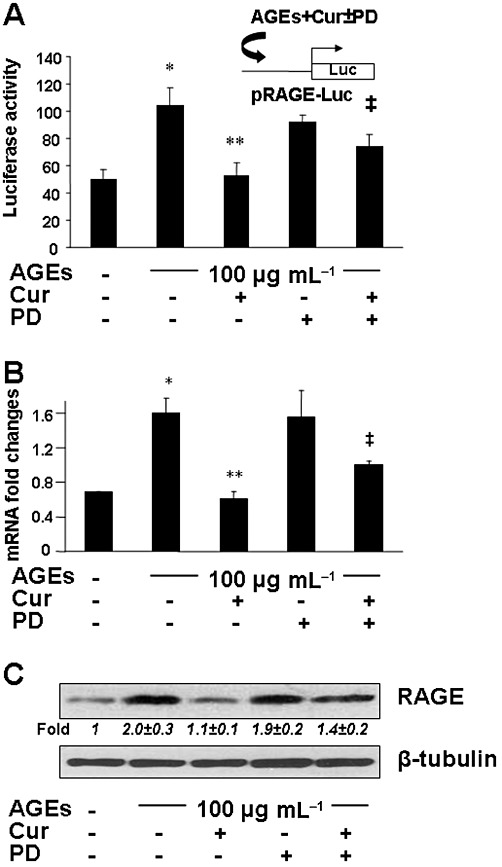Figure 6.

The activation of PPARγ played a critical role in the ability of curcumin to suppress gene expression of RAGE in HSCs. (A) HSCs were transfected with the plasmid pRAGE-Luc. After overnight recovery, cells were serum-deprived for 4 h before the treatment w/wt AGEs (100 µg·mL−1) in the presence or absence of curcumin (20 µM) and PD68235 (PD) (20 µM), a specific PPARγ antagonist, in serum-depleted media with PGJ2 (5 µM) for an additional 24 h. Luciferase activity assays were conducted (n = 6). *P < 0.05, versus untreated control cells (first column); **P < 0.05, versus cells treated with AGEs only (second column); ‡P < 0.05, versus cells treated with curcumin and AGEs (third column). The floating inset denoted the pRAGE-Luc construct in use and the application of AGEs and curcumin w/wt PD68235 to the system. (B and C) After pretreatment w/wt PD68235 at 20 µM for 1 h, serum-deprived HSCs were treated w/wt AGEs (100 µg·mL−1) in the presence or absence of curcumin (20 µM) in serum-depleted media with PGJ2 (5 µM) for an additional 24 h. (B) Real-time PCR analyses. Values are presented as mRNA fold changes (mean ± SD, n ≥ 3). *P < 0.05, versus untreated control cells (first column); **P < 0.05, versus cells treated with AGEs only (second column); ‡P < 0.05, versus cells treated with curcumin and AGEs (third column). (C) Western blotting analyses. Representatives are from three independent experiments. β-Tubulin was used as an internal control for equal loading. Italic numbers beneath the upper blot were fold changes (mean ± SD) in the densities of the bands compared with the untreated control in the blot (n = 3), after normalization with the internal invariable control.
